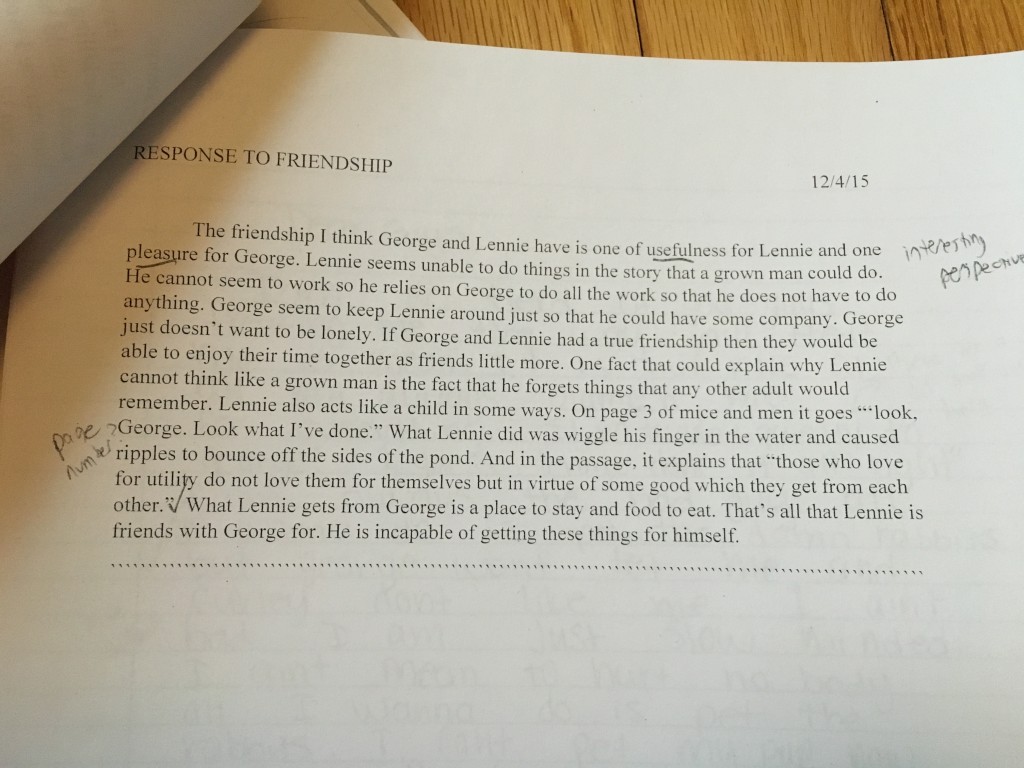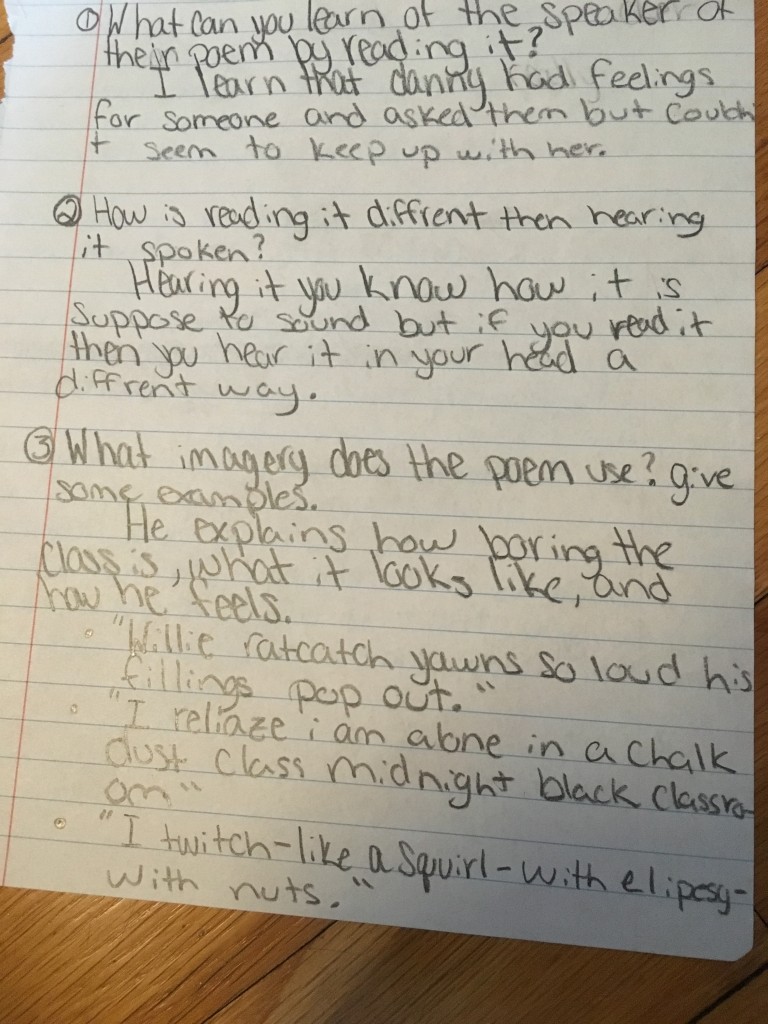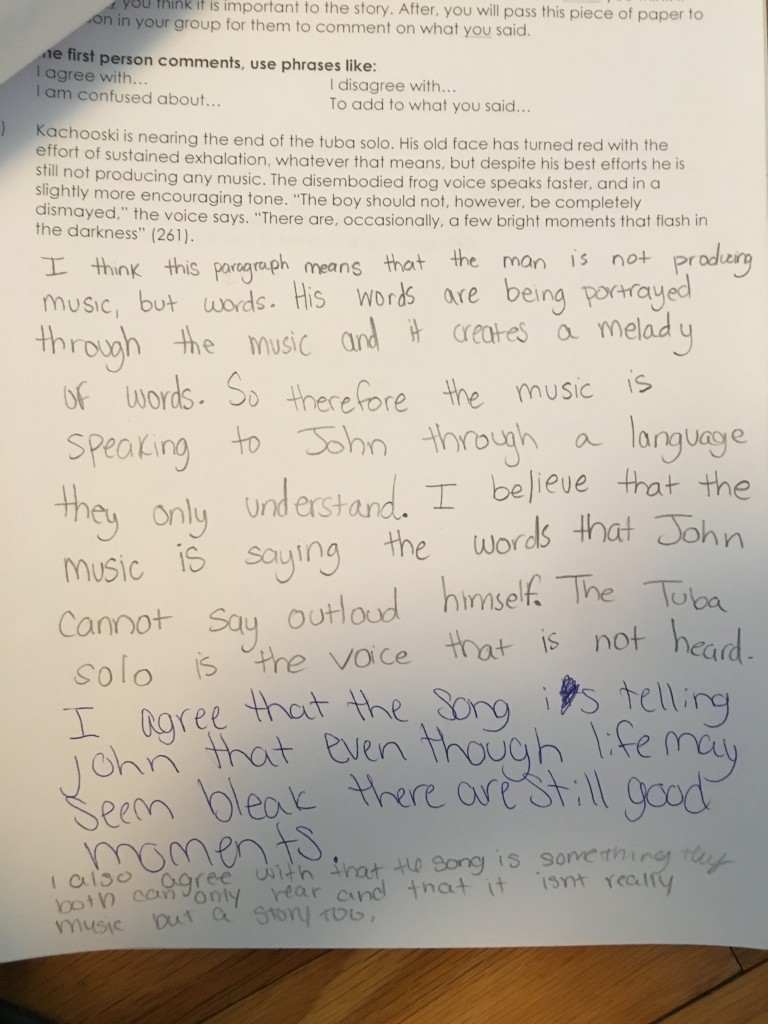From October, 2015
On my third day at Claremont Academy for the 2015-2016 academic year—before I took over any classes at all—I encountered a student who apparently felt comfortable enough with me to disclose a violent relationship that she had had years ago with a half-brother. The disclosure began a chain of events that would acquaint me with my role as “mandated reporter” as well as introduce me to the school adjustment counselor. The student was Violet, a bubbly yet insular fourteen-year-old with an obvious love of drawing and an apparent lack of focus.
I met Violet while working with my mentor teacher’s fourth period English 9 class (the class I have now taken over). During a group work activity, I noticed Violet not engaging with her partner and instead drawing cartoons. I did not know of her 504 plan at the time and interacted with her as I had other students not completing the work. I asked her to please talk to her partner. She responded that she did not want to and that she “always hated working in groups.” I mentioned that group work was important to our classroom community and then told her how I empathized because I did not always like to do group work either. I brought up that I was an only child and so I had to learn to do group work effectively. This is when she quickly blurted out that I should be grateful I did not have siblings, since, as she phrased it, “My half-brother used to beat me up all the time.” Startled, I asked her what she meant. She confirmed that her older siblings used to hit her. I asked if this was still going on; I could not get an answer in reply. I told my mentor teacher and then went to see if I could find the school adjustment counselor.
Mr. Fontaine, upon hearing about my conversation with Violet, was surprised. He knew Violet and her history quite well. He and I sat in a conference room and talked about Violet. Mr. Fontaine informed me of Violet’s lengthy 504 plan, potentially undiagnosed spectrum disorder, and IEP protocols. He called Violet into the room to talk to her as well. I was allowed to sit-in on the conversation. It seems that Mr. Fontaine was unaware of the half-brother, but apparently the attacks were a long time ago and the half-brother now lived in Florida. I would not have to file any paperwork, I was told. I learned that Violet used drawing as a coping mechanism and that she loved writing short stories. She also has a tendency not to stay in her assigned seat in class.
Shortly thereafter, I was given the opportunity to review Violet’s 504 plan. It noted her ADHD that resulted in trouble focusing and giving attention. I learned about her history of a “preoccupied and avoidant attitude” and “passive refusal” to do class work. The plan listed Violet as needing constant “encouragement and positive reinforcement, redirection, and cueing.” Necessary accommodations were listed as follows: preferential seating, communication with parents and school staff, frequent breaks and time to be alone, and positive reinforcement.
I was drawn to Violet because of my extremely surprising first meeting with her. I saw her willingness to share personal details as a contrast with her passive refusal to engage with school work. She seemed to be in her own world, and I want to find ways to encourage her to step out of it. When I read Violet’s 504 plan, I was also struck by the language of her “passive refusal.” This phrase reminded me on one of my favorite short stories, “Bartleby, the Scrivener” by Herman Melville, where the title character simply refuses to do anything except say “I would prefer not to.” Violet, in the time since I have taken over her period, has passively refused to do many activities. She says, in fact, “I would really like to do [this] instead.” How can I as her teacher best respond when a student pleasantly tells me she intends to do something else?
As a learner, Violet has shown me many of her talents. She is a phenomenal artist and she considers herself an artist before a student. I am trying to take advantage of this; once, at the end of our first week, I had told her that if she stayed in her seat during the lesson that I would allow her ten minutes at the end of class to draw a picture of what we were reading. She actually did not need the ten minutes, as she sat in her seat as I had asked for the duration of class. Violet also completed the first major assignment of the year with Mr. Weyler. This was an original poem that would be written and illustrated on a cut-out of each student’s profile. Hers was one of the most vibrant in class (image above).
Violet’s biggest challenge is staying on-track during lessons. She can be found constantly checking online avatars on the classroom computers, coloring pictures, and writing stories. She avoids group work at all costs, but does so passively. I have noticed that she rarely completes in-class writing, though she does have two or three drawings completed at the end of each class. I have already learned a lot about Violet. My support over the observational period and beyond will continue to take new forms as I formulate new approaches. Violet will need time to herself, as the 504 and IEP indicate. Teachers at Claremont give Violet space to work, though in the first few weeks I have not seen any profound attempts to engage her in the classroom community.
Mr. Fontaine has a great relationship with Violet. I will try to learn as much from him as possible. As evidenced by his surprise of the reporting of Violet’s half-brother, though, it is clear he does not (and cannot) know everything about her. What will be important for me and for her other teachers in making more personal connections with Violet so that she can build trust in us. […] I see Violet as limited in some capacities, but excelling in others. She is gifted in many ways, yet still has the 504 plan. She is in danger of becoming a self-fulfilling prophecy if teachers do not value her successes and talents. Making time to meet with her one-on-one should prove valuable. I will not phrase directives as questions, but rather will tell her “I need you to do [this] and if you do, I can offer [this] in return.” I will have to use positive reinforcements often.
From January, 2016
Violet is still Violet, which is a double-edged sword. She is still the energetic, exceptionally intelligent, stubborn student from my first interactions with her. I have seen little growth from her in her ability to self-motivate into a group setting. She consistently relies on excuses as to why she cannot do something: “It’s in my 504,” “I can’t work with him. He always acts stupid. And when I work with stupid people I get dragged into their stupidity and then I get in trouble for something I didn’t do, so no thank you,” “I am not doing that.” Her biggest areas of struggle are her passively defiant attitude and her inattentiveness. To speak to the first, Violet will find any reason why she cannot extricate herself from the computer to join class activities. I have begun unplugging the computers before class starts, which often works well. To speak to the second, Violet rarely knows what is going on in class because when she is not on the computer she is often reading a book or drawing. Her focus is lacking.
All that said, Violet improved her grade from a C- to a C in the second quarter. She and I have finally determined a good method for helping her in class. Violet does not like to be told what to do, so instead of, for example, framing something as a command (“Get off the computer and join class, Violet”) I will instead frame it as a request (“Violet, can you please get off the computer and join class?”). I would estimate a 75% success rate with this shift. She still does not actively partake in group work, but she has begun to at least join groups.
From April, 2016
Violet is making progress in her classroom community attitude. These past two weeks have worked especially well for her, as she and I have been utilizing our systems of communication put in place in January. There have been a couple days where she needs to meet with school support staff instead of partake in class, but that is included in her 504. Violet seems to know her limits.
Violet has improved her grade to a B- for the quarter! She has done better with group work lately, too, which I attribute to a couple additional protocols I put in place for her. First, every morning that we are doing group work in class, I go to her homeroom and tell her what she should expect from the day. I have recognized in the past few months that Violet is particularly wary of surprises, and so to counteract those I keep her in the loop. In a way, she thinks of it like a secret code between her and me. The second step I have taken for a smoother classroom with Violet engaging is to always select her groups carefully. I know there are two students who she will not work with no matter what, and so I pair her with other students who will support her yet push her to be her best.
My biggest takeaway in working with Violet is that I need to keep trying new strategies when teaching students with different needs than most. Violet and I constantly communicate about how to keep her feeling safe. My expectations, though, are always for her to participate and feel a twinge of discomfort sometimes, since it is my philosophy that we learning by experience, trial and error, and even failure.
For all the conflicts that Violet has had in the ninth grade with other students and with teachers, I have really enjoyed my time teaching her. She is a brilliant student when she applies herself, and an efficient one at that. She has a long journey ahead of her, but she has already come so far.






